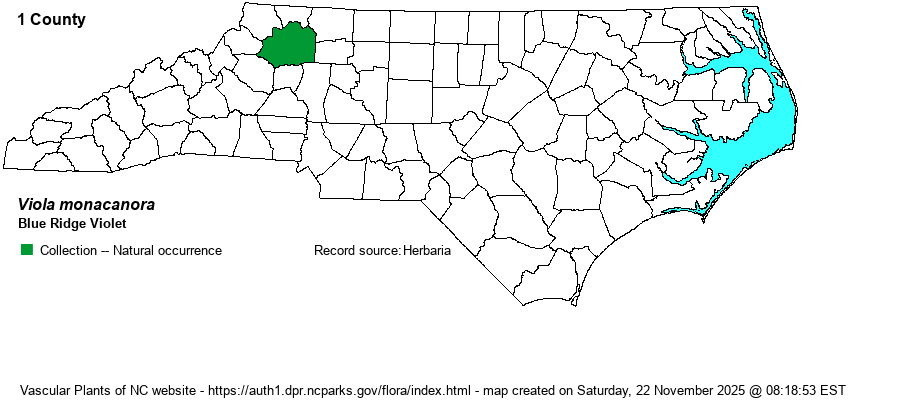| Author | J.L. Hastings & H.E. Ballard, ined. | |
| Distribution | This is a recently described species (by Ballard et al., 2023) and is split from the formerly large and confusing V. palmata complex. So far, collected only from Wilkes County, in the Brushy Mountains, in 1956; a SERNEC specimen from Haywood in 1950 might be correct but it is not within the expected range, but might be the more likely V. subsinuata. To be looked for in the northern Mountains, as well.
Limited to just VA and northwestern NC. In VA found in the Blue Ridge north to the northern counties, and ranges into the western Piedmont. | |
| Abundance | Undetermined, as this is a very recently described species, and thus there may well be specimens of the former V. palmata in various herbaria that might be this species. The only specimen was collected many decades ago (1956) by Albert Radford (NCU). Might not be truly rare, but completely unknown. Even though the only specimen was from over 60 years ago, there is no reason to think it is actually gone from NC. The NCNHP has put this species into its database, with a State Rank of SU for now, and Watch List status. | |
| Habitat | Rich mesic forests. The Wilkes County specimen label reads "mixed deciduous forest." | |
| Phenology | Blooms in April and May; fruits in May and June. | |
| Identification | This species has the typical violet blue flowers of many other violets, with the stem separate from leaves (thus acaulescent). The leaves are palmately divided, in late flower and fruit into 9-11 (to rarely 13) lobes. The central lobe is usually wider and much longer than the others. "It is distinct from other homophyllous cut-leaved violets, especially during cleistogamous fruit, in the strictly glabrous foliage (the petioles uncommonly sparsely hirtellous), peduncles and eciliate calyces, with lower surface of leaf blades, petioles, peduncles, and calyces strongly tinged with purple, the narrow and deeply biternately divided leaf blades with linear apically angulate lobes, slender acuminate sepals, and blackish seeds with minute black raised reticulations" (Ohio Univ. website). | |
| Taxonomic Comments | Formerly a part of the Viola palmata complex. See Ballard et al. (2023) for more details.
General note on Viola: In 2009-10 B.A. Sorrie (website map editor) went through the whole collection at NCU, annotating all specimens against those verified by experts in the genus. The range maps in RAB (1968) have been changed accordingly. More recently, Harvey Ballard and colleagues are in the process of revising all Eastern and Southeastern Viola, and have annotated all specimens at NCU in July 2024. They recognize additional species not in RAB or in previous editions of Weakley et al.; we will follow updated editions of Weakley et al. in recognizing them. Species range maps have been adjusted to account for identification changes. | |
| Other Common Name(s) | Monacan Violet | |
| State Rank | SU | |
| Global Rank | GNR | |
| State Status | W7 | |
| US Status | | |
| USACE-agcp | | |
| USACE-emp | | |

